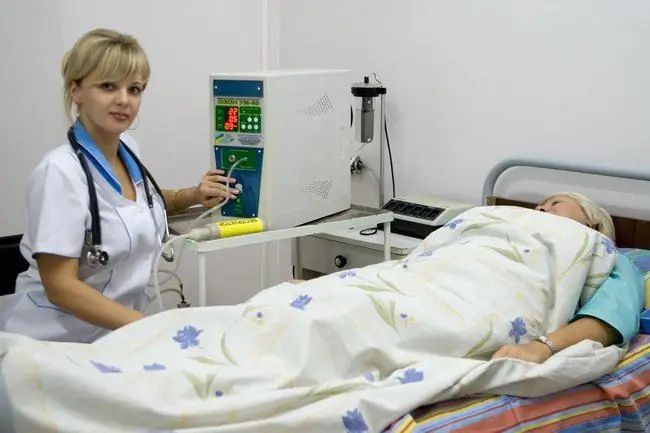- Author Curtis Blomfield [email protected].
- Public 2023-12-16 20:44.
- Last modified 2025-01-23 17:01.
Hemosorption is an invasive method of detoxification. The main purpose of the procedure is to cleanse the blood of toxins, allergens and antibodies. A positive effect is achieved due to the contact of blood with a sorbent - this substance is able to absorb components from solutions and gases.
Varieties of procedure
Depending on the sorbent used, there are two types of hemosorption. This is:
- Non-selective option. As a sorbent, ordinary activated carbon is used, which is able to absorb most of the toxic substances. This type of procedure is used to remove fatty acids, bilirubin and indoles from the body.
- Selective option. Ion-exchange resins act as a sorbent. They are distinguished by their ability to absorb a narrow range of chemicals. It is used to cleanse the blood of potassium ions, ammonium s alts.
The choice of one or another variant of the procedure is up to the doctor. In this case, the specialist should be guided by the patient's diagnosis.

Main indications
Hemosorption as one of the methodsblood purification is prescribed to patients with the following disorders and disorders:
- Quincke's edema;
- poisoning with metal s alts, alcohol;
- drug overdose;
- acute form of pancreatitis;
- pemphigus;
- exudative psoriasis;
- bronchial asthma;
- systemic lupus.
Another important indication is the presence of a food polyallergy.

Process Description
For the procedure, you need a special apparatus. It consists of a system of tubes, a pump and a hermetic container for the sorbent. It provides protection against air embolism and special pressure gauges are installed to assess the pressure in the column.
Before carrying out hemosorption, the patient must calm down. In addition, he must refrain from drinking alcoholic beverages for a week. After assembling the mechanism, blood is passed through a column with a selected sorbent. Harmful substances settle in the container. To ensure a continuous flow of blood, a pump is used, which is responsible for maintaining the required speed.
Hemosorption is a fairly serious procedure, so the patient must remain in the hospital for some time after it. After passing the tests, the doctor can let the patient go home. However, the rehabilitation does not end there. Almost all patients at home should take medication to increase the body's resistance and prevent the development of a bacterial infection.

Features of the procedure in children and pregnant women
If there are serious indications for hemosorption, this method of therapeutic action can be successfully used in children. However, in this case, constant monitoring by the attending physician is required. In case of negative dynamics, it is better to refuse sessions.
As for women in position, this procedure has found its application here. The doctor must take into account the risk of complications in the expectant mother and the potential benefit to the fetus. It is worth noting that lactation is not a contraindication for hemosorption, but it is still better to consult with a specialist before the procedure.

Advantages and disadvantages
In modern medical practice, the use of hemosorption is considered indispensable. This procedure has many advantages, including:
- the possibility of reducing the percentage of deaths in such serious pathologies as peritonitis and acute pancreatitis;
- the ability to quickly cleanse the body of poisons and toxins;
- even with low performance indicators, hemosorption has shown itself to be one of the effective methods of removing harmful substances from the body.
Among the shortcomings, many include the duration of the assembly of the apparatus for the procedure.
Patient testimonials
The opinions of patients who have already had to resort to hemosorption of blood are found only with a positive color. The procedure is validhelps to alleviate the patient's condition after poisoning with poisons or chemicals. It is especially effective in cases of bronchial asthma and systemic lupus.
Many say that the positive effect is noticeable after a few sessions. Long-term use of hemosorption allows not only to make the result more pronounced, but also to fix it for a long time. In this case, the likelihood of complications (lowering blood pressure or feverish state of the patient) is reduced to zero. Only in isolated cases, the procedure is accompanied by such negative consequences.

Hemosorption is a relatively inexpensive treatment option. As a rule, one session costs from 800 to 1200 rubles. One course of treatment requires from 4 to 12 such procedures. However, the duration of therapy is determined by the doctor, taking into account the patient's condition and the severity of his pathology. In different medical institutions, the final cost of the service may vary.






